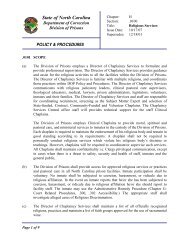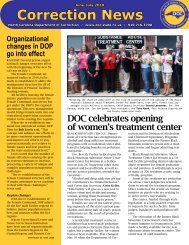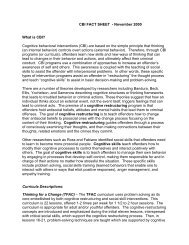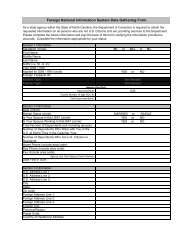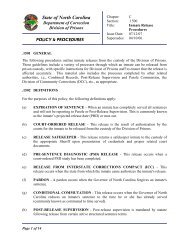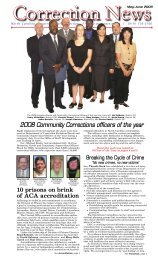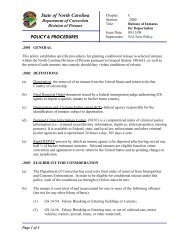Safekeepers - North Carolina Department of Corrections
Safekeepers - North Carolina Department of Corrections
Safekeepers - North Carolina Department of Corrections
You also want an ePaper? Increase the reach of your titles
YUMPU automatically turns print PDFs into web optimized ePapers that Google loves.
State <strong>of</strong> <strong>North</strong> <strong>Carolina</strong><strong>Department</strong> <strong>of</strong> CorrectionDivision <strong>of</strong> PrisonsPOLICY & PROCEDURESChapter: CSection: .1600Title: <strong>Safekeepers</strong>Issue Date: 11/01/11Supersedes: 10/05/07.1601 SCOPE AND DEFINITIONS(a)(b)The purpose <strong>of</strong> this policy is to establish guidelines for the Division <strong>of</strong> Prisons tocooperate with county jails to assist with the housing <strong>of</strong> prisoners when necessary forsafety and security reasons and to comply with the General Statutes through thesafekeeper program.The following definitions apply whenever these terms are used:(1) Safekeeper - A prisoner held in any county jail who: poses a serious escape risk;exhibits violently aggressive behavior that cannot be contained and warrants ahigher level <strong>of</strong> supervision; needs to be protected from other inmates and thecounty jail facility cannot provide such protection; is a female or a person 18years <strong>of</strong> age or younger and the county jail facility does not have adequatehousing for such prisoners; is in custody at a time when a fire or othercatastrophic event has caused the county jail facility to cease or curtail operations;otherwise poses an imminent danger to the staff <strong>of</strong> the county jail facility or toother prisoners in the facility or to other prisoners in the facility; or requiresmedical or mental health treatment.(2) Offender Population Unified System (OPUS) - The approved computerizedsystem for the <strong>Department</strong> <strong>of</strong> Correction.(3) Automated Jail Transportation Files - Computerized OPUS screens for schedulingnew admissions in the Division <strong>of</strong> Prisons.(4) Scheduling Authority - Authority designated by the Director <strong>of</strong> Prisons to theAssistant Director for Auxiliary Services to oversee admission schedulingfunctions.(5) Inmate Assignment System - Computerized OPUS screens for classifying,managing and tracking inmates’ progress through the Division <strong>of</strong> Prisons. Thisincludes custody, security, job/program activities, housing and status assignments..1602 GENERAL PROVISIONS AND NOTIFICATION(a)Admission AuthorityPage 1 <strong>of</strong> 8(1) During normal working hours, jail authorities schedule safekeepers by calling theDivision <strong>of</strong> Prisons’ transfer <strong>of</strong>fices. Admission scheduling is accomplished
11/01/11 <strong>Safekeepers</strong>(4) The jail is informed if denial <strong>of</strong> safekeepers is necessary. Form DC-116 iscompleted to document the denial..1603 ADMISSION PROCEDURES(a)(b)(c)The facilities designated in C.1605 to receive safekeepers will perform the admissionprocessing functions on OPUS as established in the Diagnostic Center Procedure Manual(DCPM).<strong>Safekeepers</strong> will be transported by jail authorities to a Division <strong>of</strong> Prisons facility. To beaccepted, all safekeepers must have an order signed by a superior or district court judge.When, due to an emergency and it is not feasible to obtain an order signed by a superioror district court judge prior to the transfer, the sheriff is authorized to sign the order andshall, as soon as possible after the emergency, obtain the order signed by the judge.Arrival at the designated facility will be documented through the OPUS arrivalconfirmation files. Upon admission, intake procedures which include identification,criminal history investigation (DCI), local orientation, and health screening will beconducted..1604 CONDITIONS OF CONFINEMENTFor safekeepers, conditions <strong>of</strong> confinement must be met as established in C.1200.Additionally,(a)(b)(c)(d)<strong>Safekeepers</strong> must be housed separately from general population inmates, except whenadmission to a medical or mental health unit is required, or when the inmate is convictedon other unrelated charges and has been committed to the <strong>Department</strong> <strong>of</strong> Correction.<strong>Safekeepers</strong> will normally be transported to and from prison facilities and county jails bythe sending sheriff. However, transportation within the Division <strong>of</strong> Prisons will beprovided by prison staff. When transporting safekeepers, the same security precautionswill be exercised as when transporting convicted <strong>of</strong>fenders.<strong>Safekeepers</strong> shall be required to maintain their living areas in a neat, clean, and sanitarymanner. This includes all tasks necessary to maintain a suitable living environment. Thisrequirement is restricted to their sleeping, dayroom, and bathing areas only. <strong>Safekeepers</strong>are generally not convicted <strong>of</strong>fenders and, therefore, cannot be required to perform otherwork assignments.<strong>Safekeepers</strong> will not participate in program activities with the general prison population,except as authorized in .1604 (a). However, they will be provided controlled access toChaplaincy, library, certain special education services for those under the age <strong>of</strong> 21, andrecreation, consistent with C .1200. <strong>Safekeepers</strong> are not eligible for sentence reductioncredits.Page 3 <strong>of</strong> 8 Chapter C .1600
11/01/11 <strong>Safekeepers</strong>(e)(f)(g)(h)(i)(j)(k)<strong>Safekeepers</strong> shall have access to the Administrative Remedy Procedure the same asconvicted inmates and their grievances will be managed through this procedure.<strong>Safekeepers</strong> shall be expected to follow the rules and regulations common to all inmates.The disciplinary procedures used for inmates are applicable to safekeepers. <strong>Safekeepers</strong>are subject to the same disciplinary sanctions as general population inmates, except theloss <strong>of</strong> sentence reduction credits.<strong>Safekeepers</strong> will be provided non-contact visits consistent with C .1215.b. Safekeepervisiting will be separate from the convicted <strong>of</strong>fenders.Safekeeper telephone calls will be consistent with D .0803(b)(3)(B), which controlsinmate access to telephone privileges.Male felon safekeepers will be clothed in a gold color jumpsuit and male misdemeanantsafekeepers will be clothed in a green color jumpsuit. Female safekeepers will be clothedin a yellow color dress for identification purposes.Upon completion <strong>of</strong> initial processing, safekeepers will be assigned to case managerswho will monitor their activities through regular contacts. Case managers will alsoreview the safekeeper files regularly to keep abreast <strong>of</strong> any housing or custodial changesthat may occur.<strong>Safekeepers</strong> shall be provided access to needed medical, dental and mental healthservices as determined by a qualified medical, dental or mental health pr<strong>of</strong>essional.<strong>Safekeepers</strong> will be exempt from medical co-pay..1605 DESIGNATION OF PRISON FACILITIES(a)The Director <strong>of</strong> Prisons will designate authorized facilities for admission and housingsafekeepers. <strong>Safekeepers</strong> are housed apart from the general population except as notedbelow when inpatient medical and mental health services are required.(1) Central Prison and Craven Correctional Institution shall receive all adult malefelon safekeepers committed from the courts. Craven will receive and housethose safekeepers determined not to pose a substantial security threat <strong>of</strong> escape orassault. Central Prison will receive medical and mental health safekeepers, as wellas any other safekeepers who are identified as a potential security threat,including those charged with First Degree Murder cases. Following admission toCentral Prison, those inmates charged with First Degree Murder will be evaluatedby appropriate staff. Those deemed to pose a substantial security risk shall behoused at Central Prison. Others not posing a significant risk may be transferredto Craven for safekeeping. All males requiring immediate medical or mentalhealth care will be admitted to Central Prison.Page 4 <strong>of</strong> 8 Chapter C .1600
11/01/11 <strong>Safekeepers</strong>(2) <strong>North</strong> <strong>Carolina</strong> Correctional Institution for Women shall receive and house allfemale safekeepers committed for safekeeping.(3) Neuse is designated to receive and house male safekeepers, ages 19 and above,charged with misdemeanor <strong>of</strong>fenses.(4) Western Youth Institution shall receive and house male youthful <strong>of</strong>fenderseighteen (18) years <strong>of</strong> age and under committed for safekeeping.(5) Polk Correctional Institution shall receive male youthful <strong>of</strong>fenders, aged-nineteen(19) through twenty-one (21) charged with felony <strong>of</strong>fenses and committed forsafekeeping.(b)<strong>Safekeepers</strong> may be housed with convicted <strong>of</strong>fenders at an inpatient prison medical ormental health unit when such is required to provide services deemed necessary by ahealth care clinician. Inpatient treatment units designated for safekeepers are as follows:Mental Health:Medical:Central Prison Mental Health UnitNCCIW Mental Health UnitCentral Prison Medical UnitNCCIW Medical InfirmaryWYI Medical Infirmary.1606 ASSIGNMENT AND TRANSFER(a)(b)Following completion <strong>of</strong> admission processing procedures, safekeepers will be assignedto appropriate prison facilities designated by the Director <strong>of</strong> Prisons as providing housingand services for the management <strong>of</strong> safekeepers.Following a safekeeper’s assignment to a designated facility, the safekeeper will remainat that facility until recalled by the court, unless:(1) the safekeeper requires medical services not available at the designated facility; or(2) the safekeeper’s behavior has deteriorated to the point that the staff at thedesignated facility feels more security is needed.(c)<strong>Safekeepers</strong> requiring medical services shall be transported to Central Prison or WesternYouth Institution, whichever is applicable. <strong>Safekeepers</strong> with emergency medical needsshall be sent to the nearest medical provider as deemed appropriate by the designatedfacility’s medical staff. Male safekeepers requiring additional security shall be referredto the Director’s Classification Authority (DCA) for appropriate assignment. Femalesafekeepers requiring additional security shall be referred to the Director’s ClassificationCommittee (DCC) for appropriate assignment.Page 5 <strong>of</strong> 8 Chapter C .1600
11/01/11 <strong>Safekeepers</strong>(d)All transfers <strong>of</strong> safekeepers for non-medical concerns shall be coordinated through thePopulation Management Section <strong>of</strong> the Division <strong>of</strong> Prisons.(1) Safekeeper Management Authority(A)(B)(C)(D)The designated facility authority is responsible for coordinating anddirecting the assignment <strong>of</strong> safekeepers.Facility assignment will be made following record reviews <strong>of</strong> pendingcharges, history <strong>of</strong> predatory behavior, criminal history, physical andmental health status, and any other relevant information provided by thejail and documented on the OR60 screens or as might otherwise be madeavailable to the record.All classification actions for safekeepers will be documented using theappropriate OPUS files.The following will be general criteria for housing:(i)(ii)(iii)(iv)(v)Adult male felon safekeepers, ages 22 and above and identified assecurity risks, except those determined to pose a substantialsecurity threat <strong>of</strong> escape or assault and those charged with FirstDegree Murder, will be admitted to Craven CorrectionalInstitution;Male safekeepers requiring inpatient medical, or mental healthtreatment, regardless <strong>of</strong> crime categorization, will generally behoused at Central Prison. This may include inmates under twentytwo(22) years <strong>of</strong> age if inpatient treatment is needed. Inmatesidentified as pending trial for capital cases, or identified assubstantial security or escape risk will be housed at Central Prison.Following admission to Central Prison, those inmates charged withFirst Degree Murder will be evaluated by appropriate staff. Thosedeemed to pose a substantial security risk shall be housed atCentral Prison. Those not posing a substantial security risk may betransferred to Craven for safekeeping.Neuse Correctional Institution will generally house adult malesnineteen (19) years <strong>of</strong> age and above committed for safekeepingand awaiting trial for <strong>of</strong>fenses categorized as misdemeanors;Female safekeepers will be housed at the <strong>North</strong> <strong>Carolina</strong>Correctional Institution for Women; andMale safekeepers eighteen (18) years <strong>of</strong> age and under will behoused at Western Youth Institution.Page 6 <strong>of</strong> 8 Chapter C .1600
11/01/11 <strong>Safekeepers</strong>(vi)Male safekeepers, ages 19-21, awaiting trial for <strong>of</strong>fensescategorized as felon, will be housed at Polk CorrectionalInstitution.(E)In those cases where safekeepers are transferred to another facility, thesending facility shall notify the committing county <strong>of</strong> the transfer..1607 USE OF FORCEThe Division’s use <strong>of</strong> force policy applies to safekeepers under the supervision <strong>of</strong> theDivision..1608 RELEASE(a)(b)(c)(d)(e)(f)(g)A copy <strong>of</strong> the safekeeper release form is required for the release <strong>of</strong> a safekeeper. Thereceiving <strong>of</strong>ficer shall be required to sign this document, which will be retained by theDivision <strong>of</strong> Prisons.<strong>Safekeepers</strong> are released only to law enforcement <strong>of</strong>ficers who present appropriateidentification. Generally, these <strong>of</strong>ficers will represent the county issuing the safekeepingorder. Upon receipt <strong>of</strong> written authorization from the committing county, the safekeepermay be released to <strong>of</strong>ficers from another jurisdiction upon presentation <strong>of</strong> identification.Transportation to and from the local confinement facility is provided by jail authorities.The Secretary, or his designee, may refuse to accept any safekeeper and may return anysafekeeper transferred under a safekeeping order when the statutory limit is reached. TheSecretary, or designee, may, when the statutory limit is reached, require the sheriffs totake custody <strong>of</strong> any safekeeper in order to accommodate an emergency request.When a safekeeper is housed in the <strong>Department</strong> <strong>of</strong> Correction for medical, dental ormental health treatment and the treatment is complete, the facility <strong>of</strong>ficer-in-charge willnotify the sending sheriff and request that the inmate be returned to the county jail.Safekeeper's personal property will be handled consistent with F .0500, Inmate PersonalProperty, for regular population inmates. When a safekeeper is transferred from onefacility to another or is returned to the county jail, his/her personal property willaccompany them the same as any other transfer or release.When safekeepers are released from the custody <strong>of</strong> the Division <strong>of</strong> Prisons, records willbe retained by the releasing facility for five (5) years..1609 FISCALPage 7 <strong>of</strong> 8 Chapter C .1600
11/01/11 <strong>Safekeepers</strong>(a)(b)(c)The <strong>Department</strong> <strong>of</strong> Correction Accounting Office bills the county jails for costsassociated with housing safekeepers in the Division <strong>of</strong> Prisons.If a prisoner is transferred to a Division <strong>of</strong> Prisons facility, the county from which theprisoner is transferred shall pay the <strong>Department</strong> <strong>of</strong> Correction for maintaining theprisoner for the time designated by the court at the per day, per inmate rate at which the<strong>Department</strong> <strong>of</strong> Correction pays a local jail for maintaining a prisoner; provided, however,that a county is not required to reimburse the state for maintaining a prisoner who was aresident <strong>of</strong> another state or county at the time he/she committed the crime for which he isa safekeeper.The <strong>Department</strong> <strong>of</strong> Correction will bill counties for the costs <strong>of</strong> extraordinary medicalcare incurred while the prisoner was in the custody <strong>of</strong> the <strong>Department</strong>. Extraordinarymedical care is defined as:(1) Medical expenses incurred as a result <strong>of</strong> providing health care to a prisoner as aninpatient (hospitalized);(2) Other medical expenses when the total cost exceeds thirty-five dollars ($35.00)per occurrence or illness as a result <strong>of</strong> providing health care to a prisoner as anoutpatient (non-hospitalized); and(3) Cost <strong>of</strong> replacement <strong>of</strong> eyeglasses and dental prosthetic devices if thoseeyeglasses or devices are broken while the prisoner is incarcerated, provided theprisoner was using the eyeglasses or devices at the time <strong>of</strong> his commitment andthen only if prior written consent <strong>of</strong> the county is obtained by the <strong>Department</strong>.(d)Facilities that have been designated to house safekeepers shall process invoices formedical and mental health services in accordance with C.1609(c) and forward them to theAccounting Office in Raleigh for payment. The DC-702 shall be completed by listing theappropriate charge code, inmate name and number, and the county to be billed.C.1600_11_01_11.docPage 8 <strong>of</strong> 8 Chapter C .1600



